







During the Summer of 2022 the Braker Brothers (Andrew and Eric Braker) took on FFI’s challenge to go on the ultimate Chesapeake Bay Watershed road trip, covering more than 1,000 miles and seven fisheries in a week. This is their account of the adventure that followed.



Growing up in Maryland, the Chesapeake Bay always inspired us. But as the watershed is so large and diverse, it seemed impossible to experience everything it has to offer. Between job commitments, maintaining relationships and navigating everything else life throws at you, being able to chisel out enough time to get to know the largest estuary in the United States often felt like a distant fantasy. However, when FFI reached out to us and conversations about raising awareness about the Bay’s diversity began in earnest, we knew that this was our opportunity to touch that distant dream. This was our moment to put life on hold, to fully embrace the ultimate Chesapeake adventure.
The trip started in Washington D.C., where we met up with FFI’s Andrew Riechardt, got acquainted with the “green machine”—our home on wheels for the next week—and began
our journey north. Winding our way through the congested streets of D.C., we were preoccupied with our destination: a place with open spaces, spring-fed creeks and hatching green drakes.
By noon, we’d made it to central Pennsylvania, where we were greeted by the Alliance for the Chesapeake Bay crew. A number of their employees and board members, including CEO Kate Fritz, were on their annual central PA fly fishing trip with the hopes of timing it with a productive green drake hatch. It just so happened that we had the same thing in mind.
We spent the day fishing a stretch of river known to hold sizeable browns and for hosting a prolific drake hatch, and we interviewed Kate Fritz about the connection between agriculture, forests, bug life and trout. As the day continued, we observed a consistent presence of the mayflies that we were searching for, but we began to second guess if we were in the right spot to experience the pinnacle of the legendary hatch. As the sun began to set, we made a lastminute decision to jump down river, where the hatch had reportedly hit hard the previous night. Let’s just say that things worked out alright.
Andrew and Eric Braker are award-winning filmmakers who are on a mission to use the power of outdoor storytelling to spark sustainable change. Through outdoor filmmaking, content creation, and influencer marketing, the Braker Brothers love to work with like-minded brands to tackle projects that align with their mission.
After an evening around the campfire and a restless night in the Green Machine, we brewed some coffee and hit the road. Thoughts of West Virginia’s rolling hills and colorful native brook trout (our favorite fish) filled our imaginations as we began our journey towards the Seneca Rocks area.
Soon we were greeted by Dustin Wichterman, Associate Director for Trout Unlimited’s (TU) Mid Atlantic Cold Water Habitat Program. We spoke with Dustin about the history of brook trout in the region and some of the projects that he and his team are working on to revitalize populations of large native brook trout. But there was only so much time for talk. Dustin graciously took us on the grand tour of the valley, an area that he knows like the back of his hand, and we fished every honey hole along the way.
Dustin knew the best spots to fish, in part, because in many cases they were on the very same sections of stream that, years ago, he had helped restore. He was familiar with

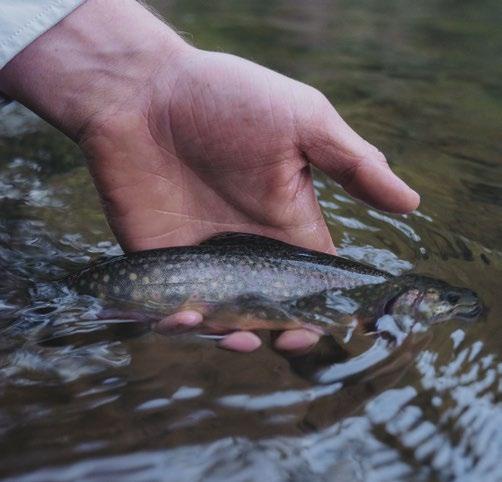
seemingly every single log, riffle and hydrological flow in each area. His passion was refreshing and inspiring. Spending time with someone who is so dedicated to restoring brook trout populations gave us hope for the future of our favorite species.


After sharing stories with Dustin late into the night, we woke up to unfavorable weather. The area we were hoping to find smallmouth bass was projected to receive rain and thunderstorms all day. As we packed up our things and begrudgingly began the journey back to D.C. for the night, we lucked into a weather window on a smallmouth river closer to home. Instead of throwing in the towel for the day, we decided that day three would be the perfect opportunity for an impromptu adventure in a new setting. Our spontaneity was rewarded. After catching a century of green sunfish, a few dozen smallmouth bass, and a handful of rockbass, all on topwater; after observing bald and golden eagles, wild turkeys, and kingfishers; and after witnessing spring-fed waterfalls and unique rocky outcrops, we could confidently say that this “throwaway” day was a major win. However, it was time to shift our attention once again.
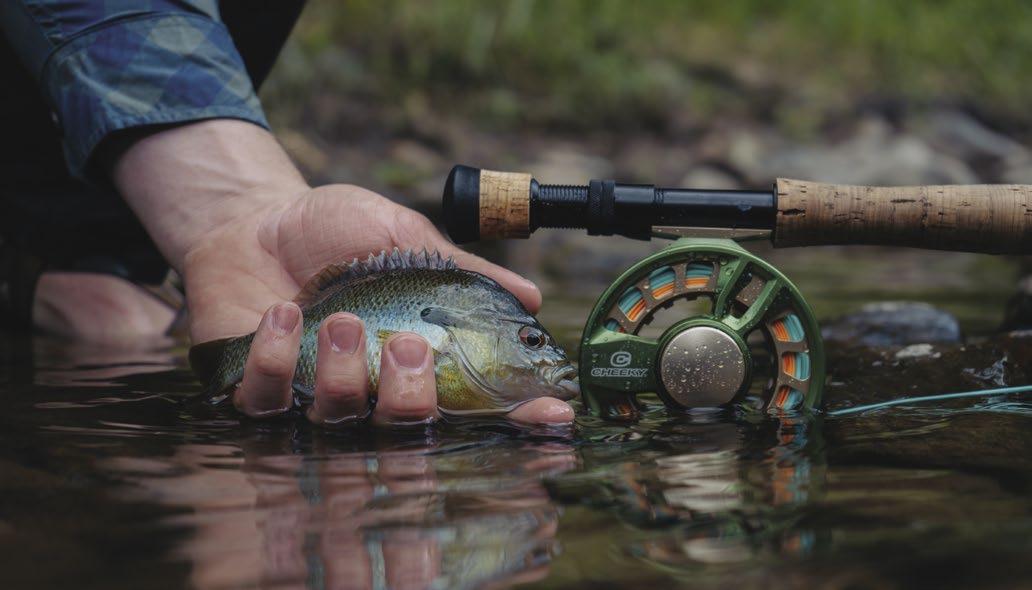
Stuck in Friday morning rush hour traffic in northeast D.C., the contrast from the previous three days spent in the woods was enough to put us on edge. As we launched the boat from a trash-filled ramp, it dawned on us that this day would be much different than the idyllic float the day prior. But we weren’t just here to wax poetic about waterfalls and rainbows, we were here to learn. Our lesson began with Phong Trieu from the Anacostia Watershed Restoration Partnership (AWRP). We spent the day with Phong, checking out various sections of the Anacostia River, sight-fishing snakehead, and discussing some of the history, and hitches, which intertwine this complicated river. Being in the heart of DC, the Anacostia has battled with maintaining healthy water quality and equitable access for recreationalists. We learned that the work that AWRP is doing is putting this river on track for a healthy and accessible future.

Due in part to an unseasonably cold spring, our timing proved to be less than optimal for targeting snakehead. We came across a few fish, but they seemed to be more interested in each other than the flies we were presenting. Humbled, and with a fresh skunking under our belt, we jumped back into the van ready for the next stage of the journey.

The next morning the Green Machine was humming down Route 95 South, headed towards the swamps of Virginia. We had plans to meet up with bowfin angler-extraordinaire and Richmond-based guide, Grant Alvis. Grant is one of the fishiest dudes you’ll meet, and his passion for bowfin, one of the oldest surviving fish species on earth, is infectious.
We spent the day poling through swampy channels and sight-fishing this prehistoric species, but we came up empty handed. A couple of willing largemouth bass helped us keep our heads up, but failing to connect with the target species for two days in a row started to weigh on us. Did we bite off more than we could chew? Was seven fisheries in seven days too tall of a task?
While we pondered the question, we continued to fish our butts off, slotting enough time to interview Grant about the state of the bowfin fishery. Eventually, we packed up to

continue the journey—this time, we were headed towards the mouth of the bay. We were ready to smell the saltwater and to embrace the opportunities that the next day would bring.


In the morning we met up with Zack Hoisington, an environmental education teacher and fishing guide with Chesapeake Coastal Charters. Zack targets a number of different species as a guide on the Chesapeake, but on this particular day we were in search of cobia.

After a morning of cruising around the bay looking for these large fish (up to six-feet long and 100 pounds), Zack was able to connect with one. We soon learned how hard cobia fight! After a long battle, Zack coerced the giant into the net. It was well into the legal harvesting size, but considering that these fish are worth much more in the water than they are on a dinner plate, we revived the powerful fish and released it back into the water.
As an environmental educator and fishing guide, Zack is a firm believer that people need to have firsthand experience in the outdoors in order to learn more about it. He also believes that education leads to ambassadorship. Zack has found that teaching and guiding is a perfect way to facilitate that transaction—one student and one client at a time.
After managing to land the massive cobia, we celebrated over oysters and shrimp, reminiscing about the day and telling fish stories into the night. Tomorrow would be the last day of the trip, and although we were disheartened the adventure would soon be curtailing, we were excited to see what the morning would bring.

In search of Chesapeake Bay striper action, we woke up early and headed up the eastern shore. We met up with our good friend and recent addition to the Chesapeake guiding scene, Jonathan Bland. While Jonathan just recently got his guide certifications, he is by no means a newbie. Born in Solomons and currently residing in Annapolis, Jonathan lives and breathes fishing the Chesapeake. We knew we could count on him to help finish the trip strong.
It only felt right that the last day of fishing on the Chesapeake Bay road trip was dedicated to catching the Chesapeake’s most iconic species. Not only was the species special, the setting was unrivalled. Jonathan took us to untouched grass flats, sandy beaches and oyster bars. The environments’ raw beauty conjured up thoughts about what the Chesapeake would have looked like hundreds of years ago—not much different than what we were looking at, we figured.

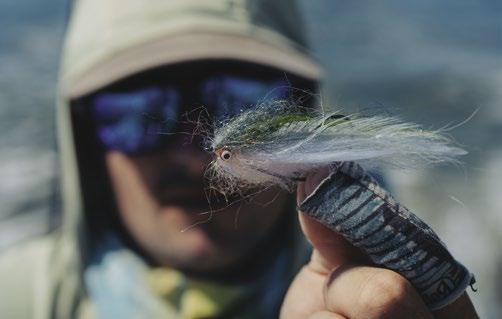
Jonathan has an important approach to his fishing and his general ethos. In order to maintain the diversity of these ecosystems and the fisheries within them, these amazing habitats and the Chesapeake as whole rely on healthy water quality. When Jonathan isn’t fishing or guiding, he is working to restore many of the tributaries within the Chesapeake Bay estuary. He has created a lifestyle balance of work and giving back to the watershed. He is able to restore headwater streams one day, then on the next outing, experience the main stem of the Chesapeake with his clients. It’s people like Jonathan who are going to fight for the sustainability of the striped bass fishery, and of the Chesapeake Bay as a whole.
Of course we wish we could have extended this trip out even further, spending more time in each fishery, and experiencing the many others that we reluctantly had to pass over. Eventually, work and life commitments come calling. The Chesapeake Bay watershed has so much to offer, that seeing it and fishing it in its entirety still feels like a fantasy, but if the Chesapeake Bay road trip taught us anything, it showed us this is a dream worth pursuing.

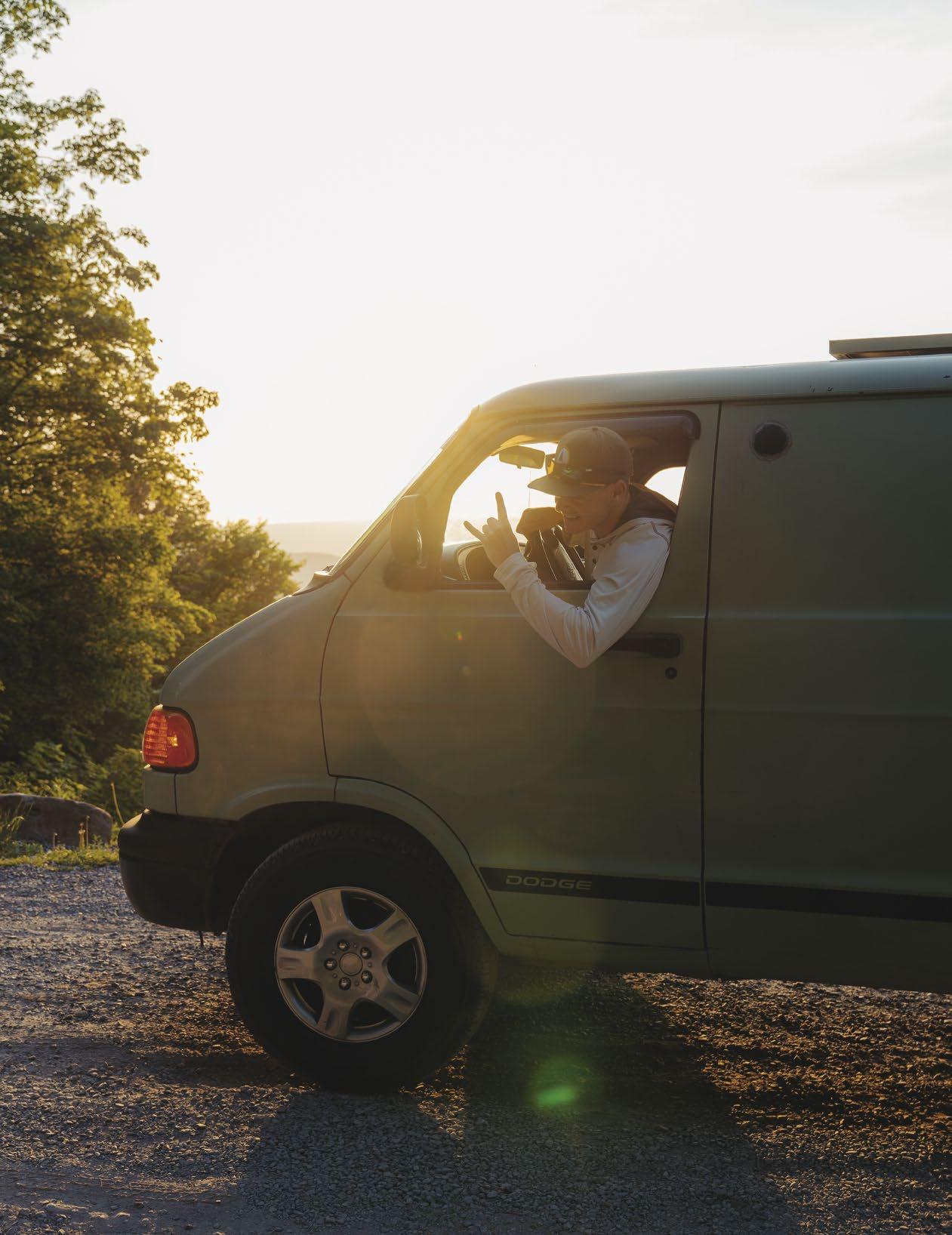
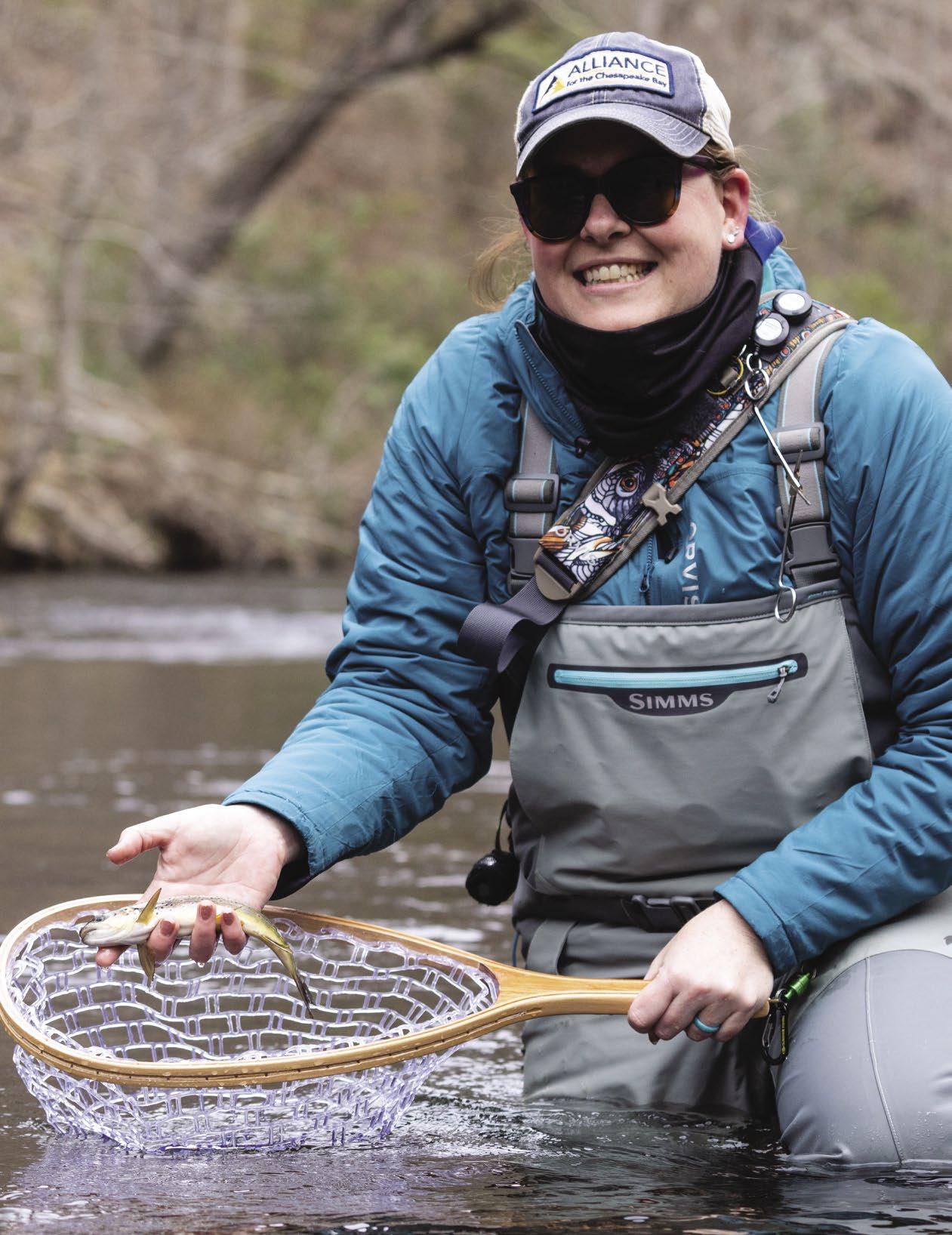 Photo Will Parson, Chesapeake Bay Program
Photo Will Parson, Chesapeake Bay Program

When you think of the Chesapeake Bay, I bet a few things come to mind: iconic blue crabs, traditional Old Bay seasoning, and rockfish. When I think of the Chesapeake, however, I think of more than 13 million acres of forests, 11,684 miles of shoreline, 3,600 types of plants and critters, 19 million residents (and counting) and an immeasurable local economic impact.
At 64,000 square miles, the Chesapeake Bay watershed is the largest estuary in the U.S. More than 150 major streams and rivers flow through the watershed, creating critical habitat for more than 348 species of fish. It’s also home to our nation’s capital, Washington, D.C., and some of the best American and Hickory shad runs on the east coast. Recognized as a “national treasure” under President Ronald Reagan, the restoration and recovery of the Chesapeake and all her miles of tributaries has been a priority for 50-plus years.
As the CEO of the Alliance for the Chesapeake Bay, and a newbie to the sport of fly fishing, I’ve learned more about the fish that inhabit our unique waterways in the last year than I have in the 18 years I’ve been working toward restoring
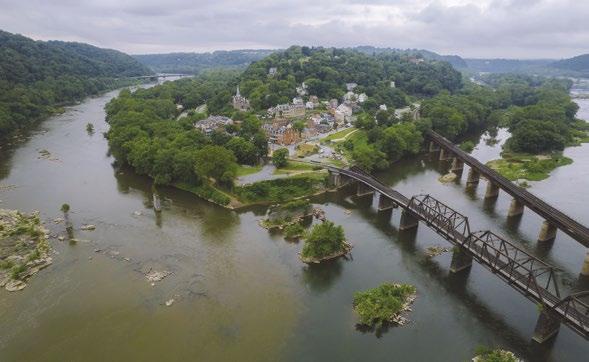
a resilient Chesapeake Bay watershed. With an academic background in biology piled on top of a penchant for leading teams that are passionate about clean and accessible water, these days, with a rod in my hand, I’ve found myself slowing down, observing streams, and asking a lot more questions. Is this a cold water stream? Was it once a cold water stream? What happened upstream to change the chemistry and biology of this reach? What kinds of bugs live here? Are there enough trees shading the water? My science background led me into a career in conservation, and conservation has led me to fly fishing.
Kate Fritz serves as the CEO of the Alliance for the Chesapeake Bay. Kate has lived in five of the seven jurisdictions of the Chesapeake Bay, and now calls Annapolis, MD home. When not standing in a stream, she’s working on making change at the intersection of land, water, and people. To learn more about the work of the Alliance, check out their website at www.AlliancefortheBay.org
The Alliance for the Chesapeake Bay is one of many nonprofit groups which has, for the last five decades, been laser-focused on the restoration of our lands and waters. Our mission is simple: to bring together the 19 million residents of the watershed to restore our lands and waters. We work with constituency groups like neighbourhoods, international businesses, local governments and everyone in between. We believe that everyone can be a part of the solution in their everyday life; that thinking globally but acting locally is truly the only way forward for a restored Chesapeake Bay.
Our work consists of getting more boots on the ground to deliver cleaner water to our rivers and streams. We do this work out of offices in Maryland, Virginia, Pennsylvania and Washington D.C. by implementing solutions in four program areas, including: Forests, Green Infrastructure, Agriculture, and Stewardship and Engagement. Our work on the ground is driven by the needs of the landscape and the stakeholders who stand to benefit from this work. We know that what ails the Bay also ails our local waters.
If you’ve ever peeked into the woods behind your local strip mall, you’ll oftentimes notice corrugated metal pipes hanging out of streams. These pipes weren’t installed this way - they were originally placed on the bottom of the stream,
in order to convey water from one place to another. They now dangle like acrobats because of the feet of sediment that have eroded downstream thanks to the hot, polluted, and fast slugs of stormwater which sluice off of impervious surfaces upstream. Surfaces like roofs, road tops, and sidewalks prevent water from soaking into the ground and filtering slowly back to the nearest stream, and instead funnel gushes of summer storms directly into our stream banks like a fire hose. These periodic conditions negatively impact water quality and actively degrade fish habitat, often resulting in the washing out of in-stream structures, sediment in the water column impairing oxygen levels, and then subsequent sediment accumulation on the riffles and runs, smothering egg-laying habitat of freshwater-spawning Chesapeake Bay fish species.
The Chesapeake Bay has lost many ecosystems that help protect our waterways, and the Alliance has been working with local communities in D.C., Annapolis, Richmond, and Lancaster to build natural spaces back into our landscape. Instead of solely relying on grey infrastructure, such as curbs and gutters and traditional stormwater management ponds, green infrastructure enables us to build small ecosystems and functions back into our landscape. Features like rain gardens, conservation landscaping, permeable pavers and rain barrels all help to slow the water down, soak it in, and spread it out. As predictions of more severe and intense storms loom on the horizon, green infrastructure will become even more critical to how we develop our landscape.
The Chesapeake Bay watershed has been deforested twice. The first time was in the 1600s, when English colonists first came to Turtle Island and subsequently cleared the land for agriculture. Before the settlers arrived, the watershed was 95 percent forested. The second deforestation took place in the 1950s. A century prior, during the Industrial Revolution, the cleared fields were going fallow and retreating back to forests. The post-World War II housing boom ensured the catastrophic loss of trees along our Chesapeake streams, which in turn contributed to the loss of coldwater habitat— zero canopy for shade on a hot day, no leafy food sources for macro-invertebrates, no tree roots stabilizing stream banks, and frequent “flashy” times of flooding in-stream. With only 57 percent of the watershed still forested today, and the loss

of approximately 100 acres of forestland daily, the freshwater streams in the Chesapeake are critically threatened.

One of the easiest, fastest, and cheapest way to restore the Chesapeake is through re-foresting our landscapes—at many scales. With approximately 80 percent of the forests of the Chesapeake held in private ownership, it becomes clear that in order to protect what we have and restore what we’ve lost, we need private landowners to step up to the plate. The Alliance works with landowners and communities across diverse landscapes and targets its tree-planting projects to those areas where they do the most good for water quality in the watershed—from stream side buffers to urban environments, and most places in between.
Oftentimes these landowners are interested in seeing their creeks and streams support a year-round trout population, something they want their children and grandchildren to enjoy into the future. The fish that inhabit a well-forested stream enjoy a multitude of benefits, including a canopy
casting shade to keep water cool, healthy insect populations, a network of roots to stabilize stream banks, and more consistent and regulated flows due to the natural filtration that trees provide. We say, “More trees, please!”
The watershed is actually made up more of land than water—an important piece of the restoration puzzle to know. As mentioned, the Chesapeake’s 14:1 land-to-water ratio, brackish quality and low flush rate in this shallow estuary means fertilizers and eroded sediments contribute to the continual decline of the Bay. When the Chesapeake cannot flush pollutants through the whole system, these extra nutrients contribute to algae blooms, which deplete the water column of oxygen and causes dangerous “Dead Zones” in the warm months. This lack of oxygen has big impacts on the migratory rockfish populations that need the Bay to spawn, and contributes negatively to overall health of the Chesapeake.
Fertilizers and manure contribute 40 percent of the
nitrogen pollution to the Chesapeake, a statistic that has remained constant over the last five decades of monitoring. While it’s not a growing source of pollution, it is also not being reduced at a fast enough rate for restoration of our local waters. Because the watershed includes important agricultural assets like the Shenandoah Valley in Virginia, Maryland’s eastern shore and western fields, and central Pennsylvania’s high-quality soil, it’s important for our restoration work to consider the economic impacts to farmers and enable them to continue to produce food for a hungry citizenry.
In order to accelerate conservation efforts throughout the Chesapeake Bay watershed, the Alliance’s agriculture team works alongside partners in the agriculture supply chain, including farmers, cooperatives, and the corporations purchasing the product. Our approach allows farms to remain sustainable while elevating environmental standards
throughout the agricultural industry.
We are working with partners like Turkey Hill Dairy, The Hershey Company, Land O’Lakes, Organic Valley, Perdue, and others, to fundamentally change the system for how food is grown and produced in the Chesapeake Bay. By working within the supply chain, we are able to braid public and private resources and bring cost-share funding for farmers utilizing best-practices to supply these companies. Corporate partners are increasingly seeking ways to reduce their carbon and water footprints, and our work together helps everyone achieve the outcome of cleaner water through environmentally-responsible farming processes that don’t break the bank for farmers.
One positive thing which came out of the COVID-19 pandemic is how many people reconnected with the great outdoors. But in this hectic world, that connection isn’t the norm—in general, as we log more screen time
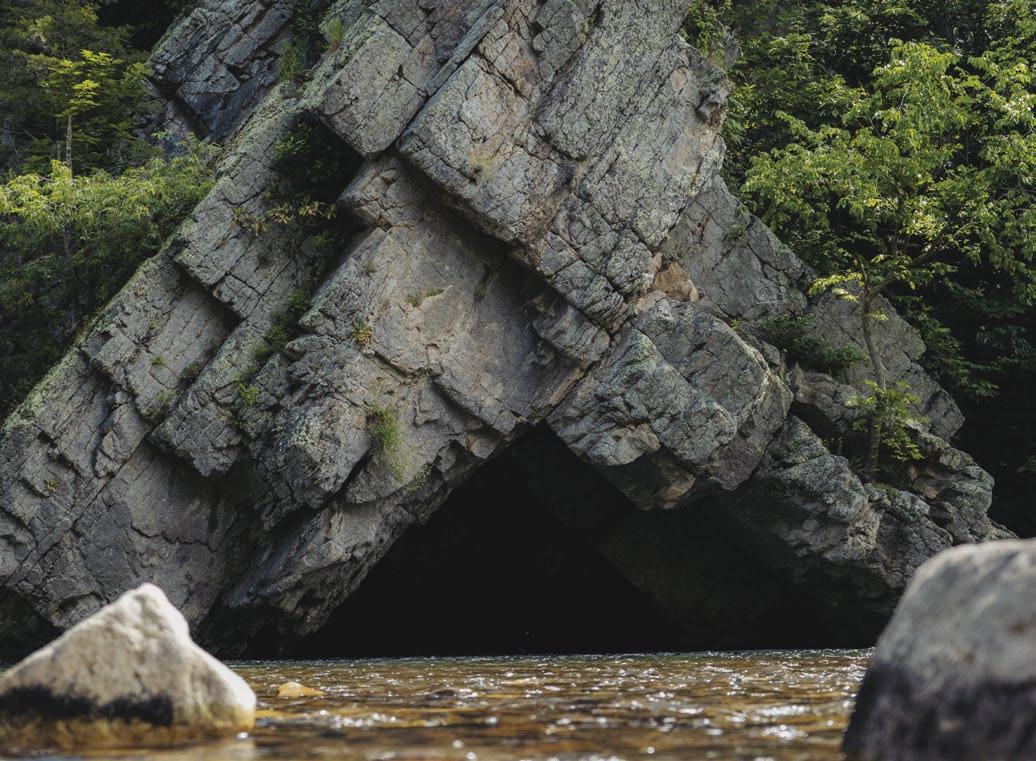
than ever, we are becoming more disconnected from the wilderness around us and suffer from the lack of meaningful relationships with our natural world. When we don’t access our natural resources, when we can’t observe them and feel them and recreate within them, it becomes more difficult to value their importance. Not only is getting outside an important part of anyone’s self-care routine, but the practice also creates more nature lovers and wilderness advocates. With the pending impacts of climate change challenges in the Chesapeake already knocking on our door, there is great urgency to continue to build awareness and engagement in these issues. The Chesapaeke is seeing local impacts of global sea levels rising, while our landform subsides—a perfect storm to drown our coastal wetlands and more frequently flood our roads, towns, and homes. Maryland’s capital, the City of Annapolis, at the heart of the Chesapeake, has seen the rate of “sunny day” flooding increase more than 925 percent since the 1960s, more than any other U.S. jurisdiction. With so much at stake, the Chesapeake Bay watershed needs all 19 million residents to be part of the solution for cleaner water.
We all live downstream of someone, and the Alliance works with our various communities, companies, local governments, farmers, and other stakeholder groups to educate people on that exact point. Through forums, conferences, events, and volunteer opportunities, we foster a deeper understanding and commitment to restoring our local lands, rivers, and streams. There are so many ways to engage people in this work, and the Alliance runs programs such as training community scientists to monitor the water quality of their local stream; building organizational and technical capacity of local watershed groups to do restoration work; and connecting stakeholders with resources to beautify their own communities. Everyone has an opportunity to positively impact their local watershed. Whether you’re reducing single use plastic with reusable water bottles and bringing your reusable bag to the grocery store, or gardening
with plants native and adapted to your region, we can all be part of the solution.
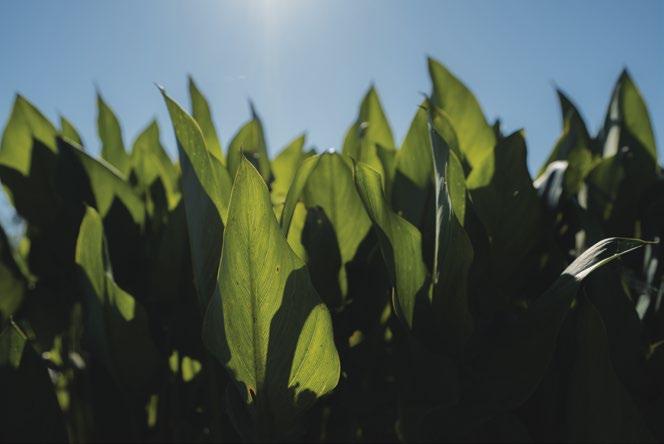
Since I picked-up a fly rod 18 months ago, many of my friends and colleagues have asked me to introduce them to fly fishing. As the sport becomes more accessible and inclusive to a greater diversification of people, it stands to be an incredible gateway for wilderness advocacy—as natural as accessing the rivers and streams of the Chesapeake Bay ought to be. In my far-ranging travels across the Chesapeake Bay, I have purchased fishing licenses everywhere I’ve gone and felt buoyed by the thought of a watershed loved, defended and supported by a wave of new anglers, their contributions and commitments helping promote conservation of the wild places we all should have the chance to explore.
The Chesapeake Bay is a watershed that contains myriad fisheries, from the famous brackish habitat of stripers, to the clear and cold native brook trout streams, to the openocean pelagic zones where cobia stalk squid, and every type of panfish habitat in between. These opportunities are what makes the Chesapeake Bay special for anglers, but even without a rod in-hand, Fly Fisher International readers will be able to recognize the watershed’s importance to more than 13 million acres of forests, 11,684 miles of shoreline and 3,600 types of plants and animals. The most important number, however, is the watershed’s 19 million residents. It’s from that population, after all, where the willingness to invest in the solutions to the Chesapeake Bay’s problems must come.
Washington D.C.’s Andrew Reichardt has served in multiple leadership roles for FFI; has advocated on behalf of the organization with conservation and corporate partners such as Trout Unlimited and Orvis; and was one of the youngest TU chapter presidents in history, leading the National Capital Chapter of Trout Unlimited for four years, with the chapter nearly doubling in membership and seeing over a 500 percent increase in both volunteer participation and fundraising. Andrew is helping lead the Chesapeake Bay Watershed Campaign: From the Headwaters to the Bluewaters . A series of films connected to the campaign will help raise the profile of the Chesapeake and the fisheries within.
Bob Covey: Can you tell me how you first got into fly fishing? Do you remember your first fish on a fly rod?

Andrew Reichardt: Yeah. It was at three in the morning, my last semester of college. I was at a party and my friend asked me if I wanted to go fly fishing. I assumed he meant the next day, but an hour later we were standing directly next to the airport, fishing for striped bass. I’d never been fly fishing before, I didn’t know how to cast. And so I was just, kind of, just trying to chuck a Clouser Minnow out there. I didn’t know how to strip, so I was just swinging it. And then I ended up hooking into a fish, putting it on the reel, and reeling it in—which took forever. So that was both my first time fishing and somehow, miraculously, my first fish.

BC: That’s a good story! What was the last fish you caught? Where were you, who were you with and what did you catch it on?
AR: I was on the Potomac River somewhere near D.C., and I caught a smallmouth bass. On a wiggle minnow, on top water, in the evening. That was two weeks ago.
BC: Let’s talk about your campaign, and your efforts to raise awareness about Chesapeake Bay. How would you describe Chesapeake Bay? And, I guess, more importantly, what does it mean to you?
AR:. Chesapeake Bay is an incredibly diverse range of

geography, geology, habitat, ecosystems, fisheries and species. It is, I believe, one of, if not the greatest place to live as a fly angler in the world. There’s not a lot of places in the world where you can have western-style dry fly fishing for a native species—brook trout—and simultaneously, only three or four hours away, be able to sight fish to saltwater species that get over five feet long, like cobia. And you could do both in the same day, if you were really ambitious.
BC: I get the sense you are really ambitious. So we’re capturing the attention of anglers who are potential advocates, and wilderness defenders, what species are you most excited to fly fish for these days? Give me a snapshot of a great day fishing in your home waters.
AR: The species that I fish for most is smallmouth bass, which are a non-native species, but are available in every major river in the watershed. However the species that I enjoy fishing for most are bowfin. They’re one of the oldest fish species in the world. They’re air breathers, so they can live in very low dissolved-oxygen environments. They primarily live in tidal swamps with low salinity. They are the top of the food chain in the environment in which they live. They can be incredibly aggressive. You’re typically sightfishing to them. They can get quite large, over three feet long. And they just look mean and nasty, but beautiful at the same time. I describe them as a heavy metal fish.
BC: Wow, and what’s typically your setup for going after bowfin?
AR: Thirty-pounds floura bite-guard, and I’m either fishing a jerk changer, a changer craw, or—I don’t believe it even has a name—but it’s the biggest, heaviest crayfish pattern you’ve ever seen.
BC: That does sound heavy metal. That’s great. Let’s talk about some of the issues that the estuary is facing. I can discover through the Internet that there are problems with Chesapeake Bay’s water quality. I gathered from some quick research that polluted storm water, agricultural runoff, sea level rise, deforestation, development, all these things contribute to its problems. In the context of raising awareness among anglers, where do you start?
AR: I would start with the solution. And I would start with why we chose to do this campaign now. And that’s because in 2014 all of the major jurisdictions within the watershed—so New York State, Pennsylvania, Delaware, Maryland, West Virginia, and Virginia, as well as Washington, D.C. where I live—all entered into the Chesapeake Bay watershed agreement. That agreement sets down specific parameters of water quality
improvements that all of the states have to meet in order to restore the water quality of the Bay itself. The work includes everything from urban to suburban to ex-urban, and the rural environment, the rural areas, agriculture, soil conservation, livestock exclusion from streams, stream bedrock, stream channel restoration, wastewater and development impacts on streams. Those urban areas are there to stay. They’re not going anywhere, and so you have to make what changes and improvements you can in a relatively non-dynamic setting. So you’re really looking at how do you, in an urban environment, develop more groundwater retention, less runoff, less flashing? And less sewage. A huge problem in the major urban areas in the Chesapeake Bay watershed is that our civic infrastructure was built in the early 20th century and doesn’t have the carrying capacities required to support the populations that exist here today.
BC: That is fairly overwhelming. Is there a way for us to zoom in a bit, so readers can have a place to start thinking about the future of this area?
AR: I think we’re at a very hopeful moment in the Chesapeake Bay’s history. Because of that agreement, we have a range of players from the federal government, all of the state governments, the local jurisdictions, NGOs such as FFI, as well as private citizens, and even for-profit enterprises all taking actions, that, while each one may seem small, can have a large collective impact. For instance, a private citizen here in D.C. installing one rain barrel is not going to make a significant impact. But if you have hundreds of thousands of rain barrels, all of a sudden you do have a material impact on the watershed that you’re living in.
BC: I feel better already. You’ve had good success in reviving your local Trout Unlimited Chapter. For other people that might be faced with declining membership and interest in their local club, what was key for you in bridging the gap between, let’s call them “the old guard,” and new anglers?
AR: Patience and persistence. The ways in which young people, younger generations, and older generations communicate and think can be very different. But finding ways to convey common values and common ideas in ways that both sides can ultimately understand and agree upon is a huge part of it. The other thing is that, really, for grassroots organizations like TU or FFI, for the grassroots chapters, clubs and councils to succeed, it requires both generations really playing a role. Finding a way to utilize the energy and often the creativity of younger people with the experience, wisdom, and also, yeah, quite frankly, the
time that empty nesters or retirees have is key. That’s really how you make this work. It takes those two groups, with some assist from families and young people in high school and college, and even younger people as well as their parents, but really, it’s those two demographics that make these groups click. Young people oftentimes want to change everything right away. That can be seen as disrespectful by people who’ve been there for decades, and really worked hard to build an organization. On the other hand, it takes open mindedness from the older guard. Just because somebody has a new idea, it doesn’t mean they’re necessarily being critical of what’s been done before. Sometimes new ideas and new blood can really transform an organization. But you have to give it a chance.
BC: Tell me about the message you hope the entries in the film festival tour will convey?
AR: They’re a celebration of the Chesapeake Bay watershed. I really meant it when I said I don’t believe there is anywhere better to live as a fly angler. The films are really going to shock people who aren’t familiar with this area, how much of an under-the-radar gem the Chesapeake Bay watershed is. It’s really that diversity of species that I think people will find really fascinating.

BC: What can the future hold for the Chesapeake Bay watershed? And who needs to be convinced to get it there?
AR: I think the future is still to be determined. It will never be restored to the state it was when John Smith sailed into the Chesapeake Bay and you could see through to the bottom, down 50, 60 feet, because the oyster populations were so massive that there was almost no suspended solids in the water at all. But it can be a lot better than what it is. That only happens if we, the general public, advocate for the resource. That means at the federal level all the way down to your local town council, asking what is all this water treatment? Where does our wastewater go? How is it treated? Are there small, outdated dams in our neighborhood?
At the local level is really where groups like FFI can affect things like small-scale dam removal, or identifying culverts that affect fish passage, but also act as barriers to sediment transport down the stream, for example. Those are smallscale projects, but once you add them all up they make a large-scale impact.
If the general public doesn’t advocate for the resource, the resource will not receive the care that it needs to be restored.
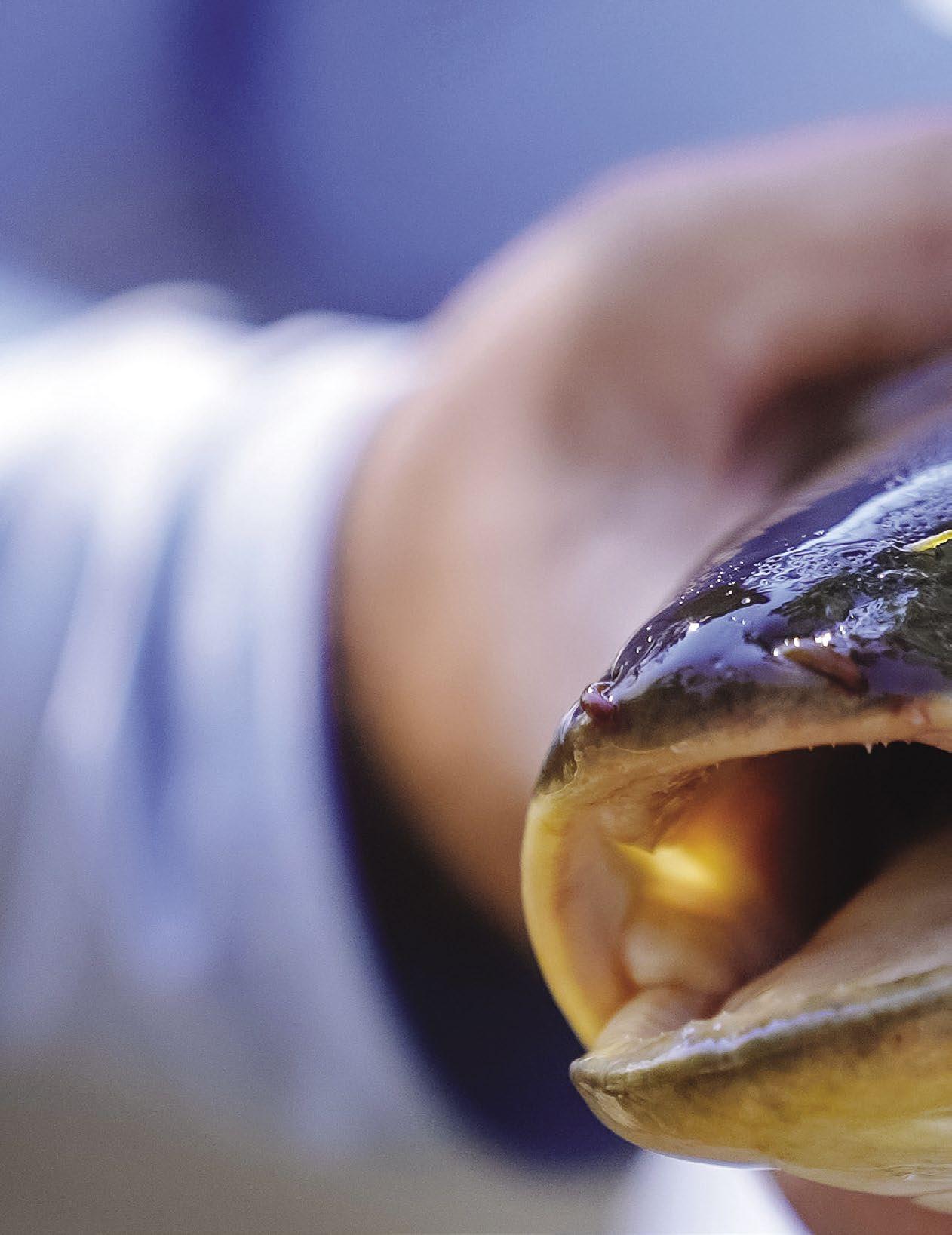 Photo Eric and Andrew Braker
Photo Eric and Andrew Braker

They go by many names: mudfish, dogfish, Cypress trout, choupique and grinnel. Regardless of what you call them, bowfin (Amia Calva) are one of the top predators in their ecosystem, no matter where they’re found.
A true living dinosaur, bowfin as a species have remained nearly unchanged for millions of years. And who could blame them? Why evolve when you’re already perfect?

Do you enjoy sight fishing? How about sight fishing to big fish? What about sight fishing to big, acrobatic fish that make vicious, repeated attacks on the fly? Fish whose fight doesn’t seem to have an off switch? Do you enjoy targeting native species that are still living in the same waters they’ve inhabited since before humans walked the earth? If you said yes to any of those questions, then bowfin might just be for you.
On average, bowfin are larger than most fish freshwater fly anglers typically target. Smaller bowfin hover around four pounds, while the larger fish commonly exceed double digits. Bowfin offer a unique opportunity for almost flatsstyle sight fishing, but in freshwater. Often laid-up on mud, next to downed trees or grass lines, bowfin’s natural camouflage adds to the challenge of targeting them and, for my money, makes the experience even more exciting. Spotting these fish strongly depends on water conditions and sunlight, and when one or both of those variables isn’t cooperating, the odds stack heavily in the bowfins’ favor. If you do have good water clarity, once spotted, the approach, cast, retrieve and hook-set must be executed expertly, with little room for error. The angler has to remember that these fish are a multi-million-year-old species. They didn’t survive that long by being easy to catch. Fishing for bowfin is all about the challenge; if they were easy to connect with, the experience wouldn’t be nearly as much fun.
Bowfin inhabit most of the eastern and mid-western United States. Typically synonymous with the Cypress swamps of the South Eastern U.S., most anglers don’t realize these
areas are but a small fraction of their native range. Bowfin typically prefer stagnant or slow-moving waters, and because they are bimodal breathers (they have the capacity to breathe both water and air), they can survive in extremely oxygen-poor environments. Bowfin are a predator species, so when fishing for them, you’ll do well to remember that small baitfish, crustaceans and amphibians make up the vast majority of the bowfin’s diet. Searching areas with high concentrations of these food sources is always a great place to start. Additionally, bowfin are almost always structureoriented. Wood and other hard structure‚ including docks and rocks, make up their primary habitat. In the absence of such structure, grass lines and drop-off edges of mud or sand flats offer great ambush points for predators and are great places to concentrate your search.
Bowfin fishing is a warm weather affair. Typically bowfin become fairly dormant in the winter, only really feeding during warm spells and targeting small, slow-moving prey. Once the water climbs above the 60 degrees-Fahrenheit mark, the fish become far more active. Heat doesn’t put them off; bowfin seem to be most active during the warmest weather of the year and even in the middle of the day in 90 degree water they’ll eat surface patterns with reckless abandon.
When targeting bowfin, the most important thing to remember is ambush points. Just like any other predator, the bowfin will use structure and cover to its advantage. Fishing flashy baitfish patterns close to cover, or dragging crayfish flies around rocks and wood structure, are great ways to locate these fish. If you’re fishing tidal water, lower tide or falling tides are always best. The falling water will funnel baitfish and crustaceans out of the shallows and into the waiting mouths of hungry bowfin. They are not unlike muskie in how they will often follow a fly all the way back to the rod tip— often multiple times.
While they are apex predators, bowfin are also very curious fish that will investigate anything new which enters
When Grant is not behind the wheel of a UPS truck he spends his days either on the bow or poling platform of his skiff targeting or introducing people to any number of the amazing fish his home waters of Virginia. From Bowfin to Brook Trout, Redfish to Snakeheads, Grant lives for the thrill of chasing anything that swims.

their environment. Sometimes brightly-colored or flashy flies can be a serious cheat code for bowfin, especially in dark or muddy waters where sight fishing isn’t an option. When sight fishing is an available technique, getting a look from a high-as-possible vantage point is advantageous. It may not sound like much, but getting your eyes even just 12 inches higher in the air can make the difference between spotting a fish at 10 feet or 10 yards. This vertical view can make or break the entire sight fishing experience.
When a fish is spotted, it is crucial to be able to diagnose the fish’s mood. This might sound nebulous, but bowfin have a tell-tale sign that will easily help you understand their state of being: their dorsal fin. The bowfin’s dorsal fin extends down the length of their body. When the fish is agitated, the dorsal slowly and methodically starts to undulate in a wavelike motion, down its back. Once you see it, you’ll recognize it. If the dorsal begins moving quickly, or there is a lot of
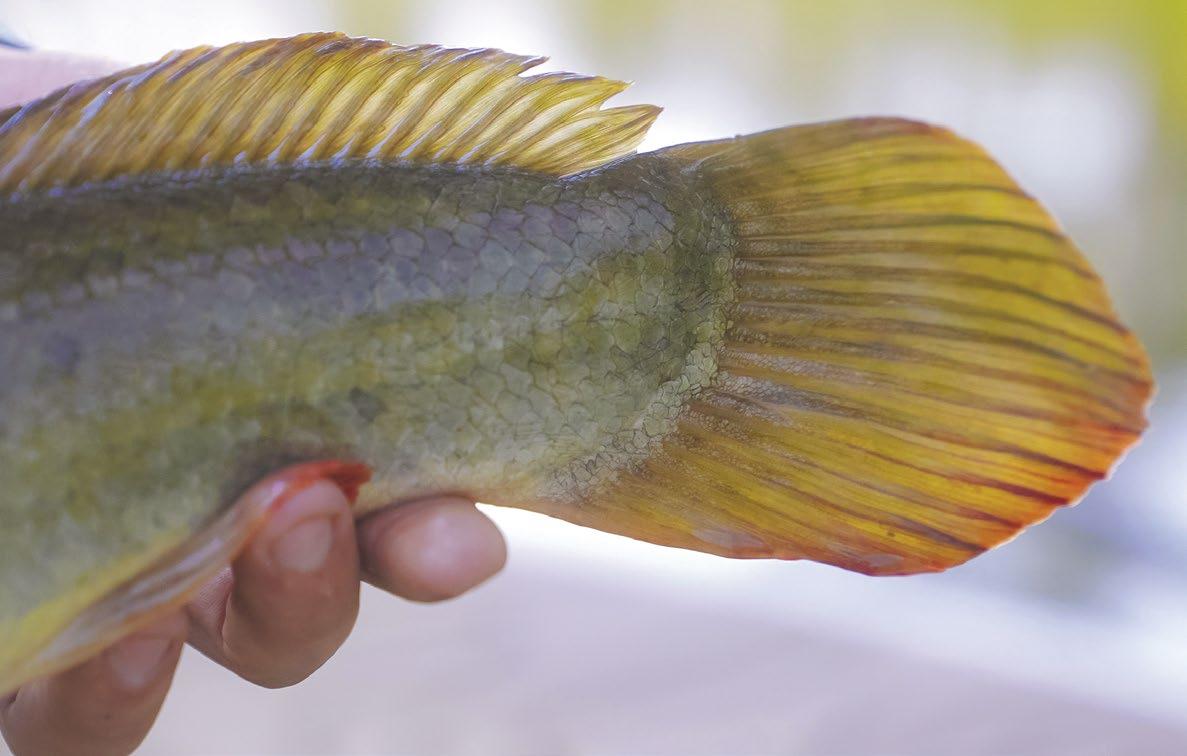
movement in the fish’s pectoral fins, it’s almost a guarantee that the fish knows you’re there and is unlikely to eat your fly. Interestingly, if the fish is sitting completely still, without any sign of agitation, it’s game time. When casting at a fish that’s laid-up, bottom-bouncing flies are the best strategy. Anything that resembles a crayfish will trigger bites when fished slowly past their face; and if the fish doesn’t attack on the first few casts, don’t give up. It’s not rare to make four or more casts at a laid-up fish before it decides to bite. Even dragging a fly directly across the fish’s nose can trigger a violent take.
Powerful fish require powerful tackle. An 8-weight, fastaction rod will cover most bowfin applications, however, fly casters not used to throwing heavier or larger flies might consider bumping up to a 9-weight, just to make casting easier. The fly line is another very important part of the bowfin arsenal—depending on location, the climate-style
of your fly line can make or break a bowfin trip. In the southern U.S., tropical lines are necessary to combat the sweltering summer heat, whereas in the bowfin’s northern reaches, a more common warm water fly line will do fine. The reason it’s important to pay attention to the climatestyle of your line is so that your casting doesn’t suffer. Lines meant for cooler climates will become soft and often sticky in hot weather, making casting nearly impossible. A short, powerful, tapered fly line is perfect for bowfin angling. The line’s shorter head will allow for quick loading of the rod and facilitate accurate casting at close range. The powerful lines will also help carry wind-resistant and heavy flies to their target with ease. Leaders for bowfin fishing don’t need to be anything fancy. A two-foot butt section of 30-lb monofilament with six-to-seven feet of 20-lb monofilament or fluorocarbon as “tippet” is perfectly serviceable. Due to its lack of stretch, as well as its abrasion resistance, fluorocarbon makes a great bowfin leader. The lack of stretch helps with the difficult hookset into near-solid, bony mouths and the abrasion-resistance helps avoid bite-offs from the bowfin’s razor sharp teeth. In my experience, wire tippet is overkill and tends to decrease the number of takes.
The least important part of your outfit when targeting bowfin on the fly is the reel. While these fish are very powerful, they rarely make long runs; it’s unusual to be relying on your backing. They will, however, spray water 10 feet into the air, jump clear out of the water and dive under the boat. That being said, to aid in picking up line, as well as helping prevent kinks and twists, a large arbor reel is always a nice piece of equipment to have.
Your selection of bowfin flies need not be extensive. A small variety of baitfish patterns, surface baitfish (or frog imitations) and crayfish flies will cover 95 percent of all bowfin circumstances. Three-to-five-inch baitfish patterns, such as Game Changers, Murdich Minnows and larger Wooly Buggers are usually enough to pique the interest of a bowfin. Typically, baitfish patterns work best for cruising fish or for fish tucked into wind-blown bays, stucture or sandbars. In my experience, crayfish imitations are your best option for sight-fishing. Game Changer Craws, CK Clawdads and Nearnuff Crayfish are great options when you’re lucky enough to see a bowfin laid-up in a fishable location. If you’re really into chasing that adrenaline rush, you may want to give topwater bowfin a try. They will often
come up and inspect poppers, diving frogs and sliders. Occasionally they will explode on the fly like a muskie and other times they will follow the fly for 10 feet or more before sipping it off the surface like a trout.
My recommended gear list for targeting bowfin contains only a few things that most fly anglers may not already have in their quiver. One such item is a BogaGrip, or any other similar catch-and-release facilitating gripping tool, so long as it has the ability to swivel. Bowfin are tough fish and can create jaw pressure that would impress a crocodile. A gripping tool allows the angler the ability to securely hold the fish, and it helps relax the bowfin’s jaws, which will give the angler a chance to retrieve the fly, should it not be easily reachable. The other critical piece of bowfin gear is a net with rubberized-nylon. Solid rubber mesh nets can work, however, if a bowfin starts to roll violently—which they often do—there is the danger of the fish getting wrapped up tightly and breaking the rubber mesh. Rubberized nylon, on the other hand, can take a beating and is still gentle on the fish. Another, more common piece of essential equipment for targeting bowfin are polarized glasses with either greenmirror, amber or copper lenses to cut the glare in most freshwater environments. While I’m at it I might as well add in stripping guards. The hookset to connect these fish to the fly is a hard strip-set, combined with a rod lift. Particularly with the new textured fly lines in use today, that hard stripset can take a toll on your fingers. Stripping guards will protect your fingers and they also help keep slime from accumulating on fly lines.
Bowfin are a formidable opponent for even the most seasoned fly anglers. Whether its the bone-jarring eats or the eye-crossing hooksets required to get the hook to penetrate, these fish will test your patience as well as your tackle. Anglers looking to sight fish for a powerful, acrobatic, heavy-hitting native species need not travel all over the country to do so. It’s time to take advantage of one of the most exciting gamefish in America that is likely right in your backyard. Whatever you call them—mudfish, dogfish, Cypress trout, choupique or grinnel—put a little respect on the bowfin’s name. They’ve been the apex predator in their environs for millennia for a reason.
The President’s Club at Fly Fishers International represents the highest level of financial commitment to the organization and comes with exclusive benefits and opportunities as a way of thanking donors for this level of generosity. Over the course of FFI’s history, the President’s Club has been instrumental in our ability to ensure the legacy of fly fishing for all fish in all waters. Members of the exclusive giving circle can support any program or project at FFI that most inspires them, and at a level that recognizes their level of giving, including Platinum, Gold, Silver, or Bronze.

